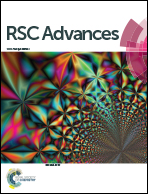Bipyridine-functionalized amphiphilic block copolymers as support materials for the aerobic oxidation of primary alcohols in aqueous media
Abstract
Amphiphilic block copolymers with 4-methoxy-4′-alkoxybipyridine ligands in the hydrophobic block were synthesized by cationic ring-opening polymerization. The bipyridine moiety was either introduced directly as a 2-oxazoline monomer (P1) or by polymer-analogous coupling to a precursor poly(2-oxazoline) with chloropentyl side chains (PP2–PP7) to prepare the polymer ligands (P2–P7). The polymers were characterized by NMR and SEC measurements to determine polymer composition, molar masses and polydispersities. In water, these polymers form micelles with cmc values ranging from 1.8 to 22 μmol l−1. SAXS and DLS measurements exhibited spherical particles with particle sizes of 8 to 21 nm. Polymers P1–P7 were finally utilized to carry out the aerobic oxidation of primary alcohols, including allylic, benzylic, and aliphatic derivatives at room temperature (T = 20 °C) and ambient air in aqueous media indicating higher activities for P2–P7 compared to P1 as a consequence of the different preparation methods. Moreover, product isolation and catalyst recycling can be easily accomplished by solvent extraction five times without significant loss of activity.


 Please wait while we load your content...
Please wait while we load your content...